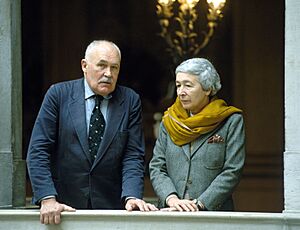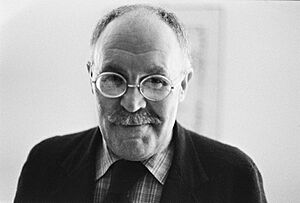Pontus Hultén facts for kids
Pontus Hultén (born 1924, died 2006) was a famous Swedish art expert. He collected art and directed museums. Many people think he was one of the best museum leaders of his time. He led the Museum of Modern Art in Stockholm. Later, he helped create the Centre Georges Pompidou in Paris. He was its first director from 1974 to 1981.
Contents
Early Life and Art Career
Pontus Hultén was born in Stockholm, Sweden. He studied art history at Stockholm University. In the 1950s, he worked as a curator at a small art gallery. He also organized film showings. In 1958, he put together an exhibition called Constructivist Design in Paris.
Leading the Moderna Museet
In 1960, Pontus Hultén became the head of the Moderna Museet in Stockholm. He made this museum a very important place for modern art. Under his leadership, the Moderna Museet became one of the most exciting contemporary art museums in the 1960s.
Hultén helped connect art from Europe and America. He showed many works by famous artists. These included early modern artists like Vincent van Gogh and Paul Klee. He also showed modern artists such as René Magritte, Jackson Pollock, and Wassily Kandinsky. Swedish artists like Sven Erixson and Sigrid Hjertén were also featured.
Exciting Exhibitions
Hultén organized special exhibitions. In 1962, he presented 4 Americans with Pop art artists Robert Rauschenberg and Jasper Johns. He also held solo shows for Claes Oldenburg, Andy Warhol, and Edward Kienholz. In 1964, he put on one of the first big European shows of American Pop art.
Because of his success, Hultén was asked to organize an exhibition in New York City in 1968. This show was at the Museum of Modern Art. It explored how machines were used in art, photography, and design.
Growing the Collection
In 1963–1964, Hultén held an exhibition called Önskemuseet (The Museum of our Wishes). After this, he convinced the Swedish government to give the museum money. This special grant helped the museum buy more art. They added works by artists like Ernst Ludwig Kirchner, Max Ernst, Joan Miró, Salvador Dalí, Piet Mondrian, and Pablo Picasso.
The museum became world-famous in 1966 with an exhibition called SHE – A Cathedral. This was a giant sculpture of a woman lying down. Visitors could walk inside her "womb" and experience different things. The artists who created this work were Niki de Saint Phalle, Jean Tinguely, and Pontus Hultén himself.
In 1968, the museum hosted the first ever major show of Andy Warhol's art. An art critic named Carl-Johan Malmberg said that Pontus Hultén "understood what good art was way before others did." This meant he was ahead of his time.
Creating the Centre Pompidou
In 1973, Hultén left Stockholm for a very important part of his career. He became the first director of the new museum of modern art at the Centre Georges Pompidou in Paris. This museum opened in 1977.
Hultén organized huge exhibitions there. These shows explored how art history was made by connecting different art cities. Examples include Paris-Berlin, Paris-Moscow, and Paris-New York. These exhibitions showed not only art, but also films, posters, and documents. They even recreated old exhibition spaces. These shows were very new and exciting. They combined many different types of art and ideas. They are still remembered by artists and curators today.
Later Career and Legacy

After the Centre Pompidou, Hultén continued to work closely with artists. He was invited to help start the Museum of Contemporary Art (MOCA) in Los Angeles in 1980. He worked there for four years.
From 1984 to 1990, he was in charge of Palazzo Grassi in Venice. In 1985, he helped create a special art school in Paris. He described it as a mix between the famous Bauhaus and Black Mountain College schools. From 1991 to 1995, Hultén was the artistic director of a big art hall in Bonn, Germany. Later, he became the director of the Jean Tinguely Museum in Basel, Switzerland. He organized its first exhibition.
Niki de Saint Phalle, an artist he worked with, once said that Pontus Hultén had "the soul of an artist, not of a museum director."
Pontus Hultén believed that a museum should be an open and flexible place. He wanted museums to host many activities. These included talks, film series, concerts, and debates. He had special friendships with artists like Sam Francis, Jean Tinguely, and Niki de St. Phalle. He not only followed their careers but also helped shape them.
Hultén loved art his whole life. He was a passionate art collector. In 2005, he gave his private collection of 700 artworks to the Moderna Museet. He asked that these works not be hung in the main galleries. Instead, he wanted them to be in a special viewing area. This way, people could look through the masterpieces like they were in an art library. After he retired, he lived in Paris and Stockholm. He passed away in Stockholm.


